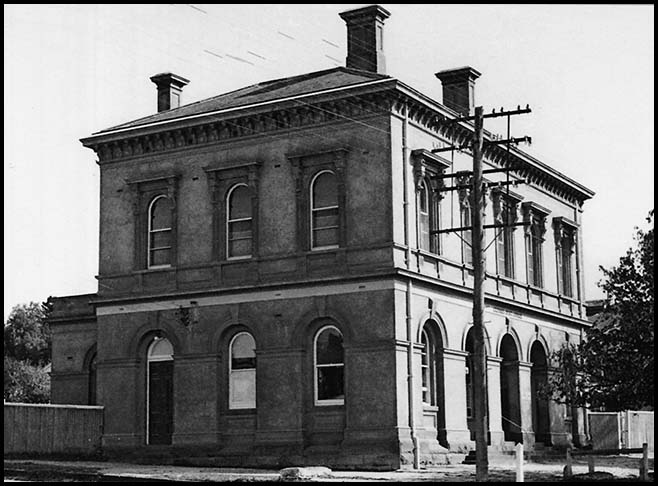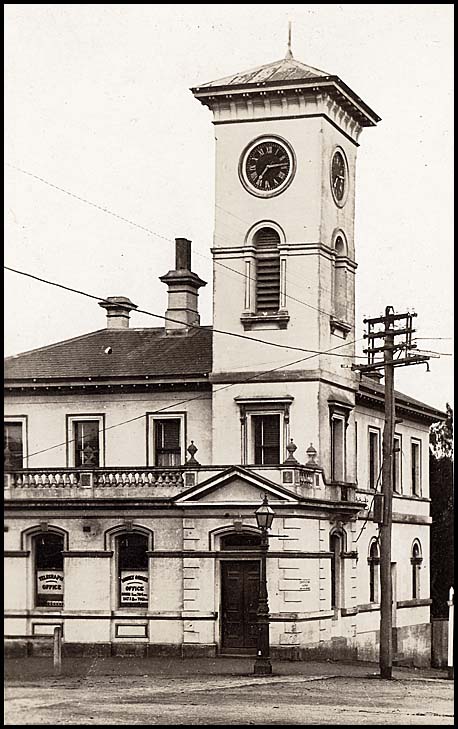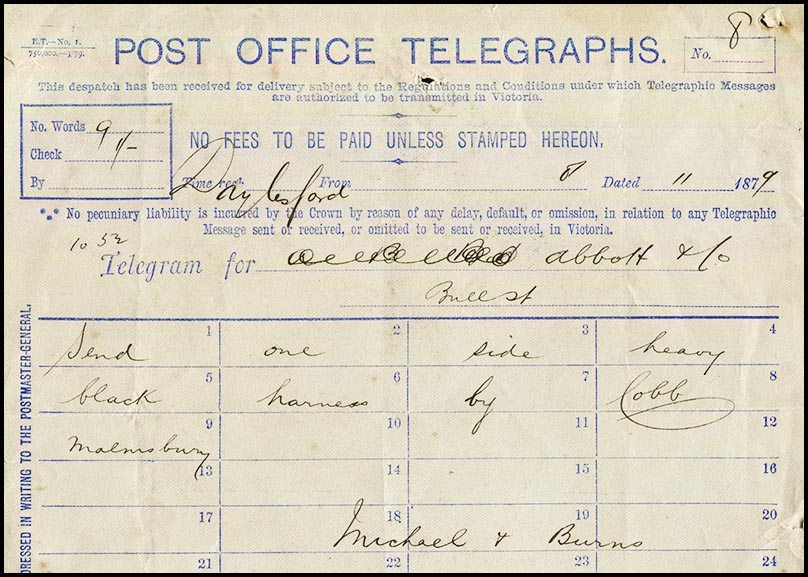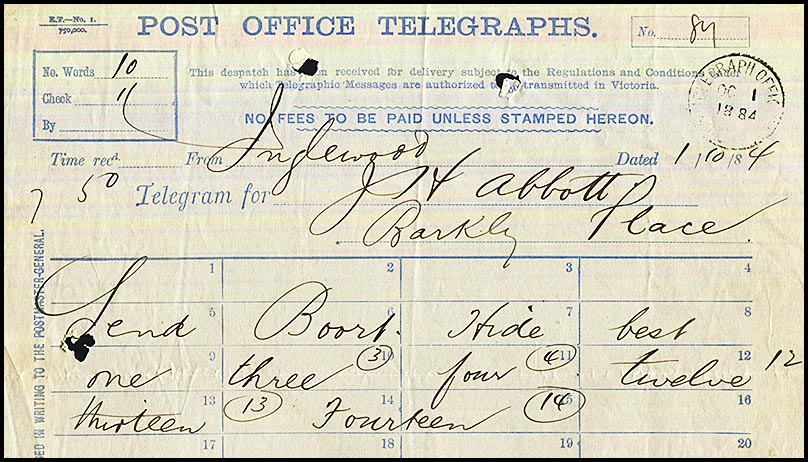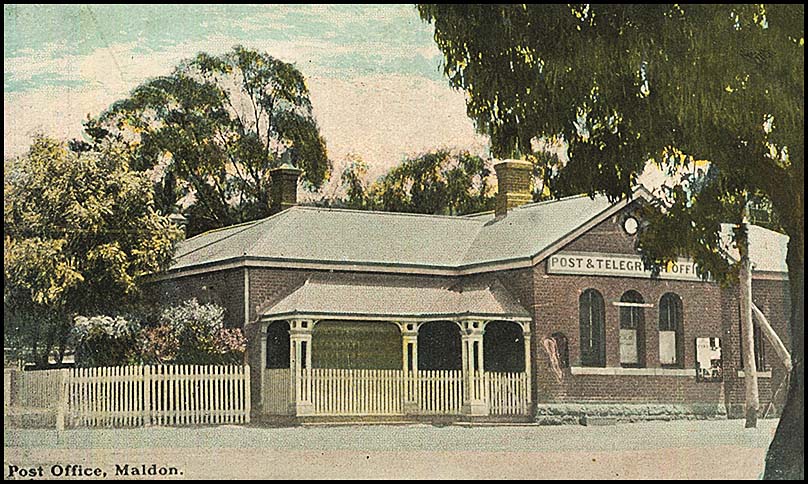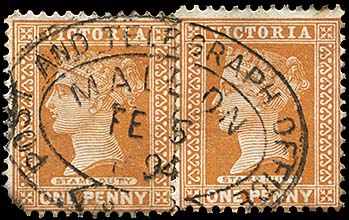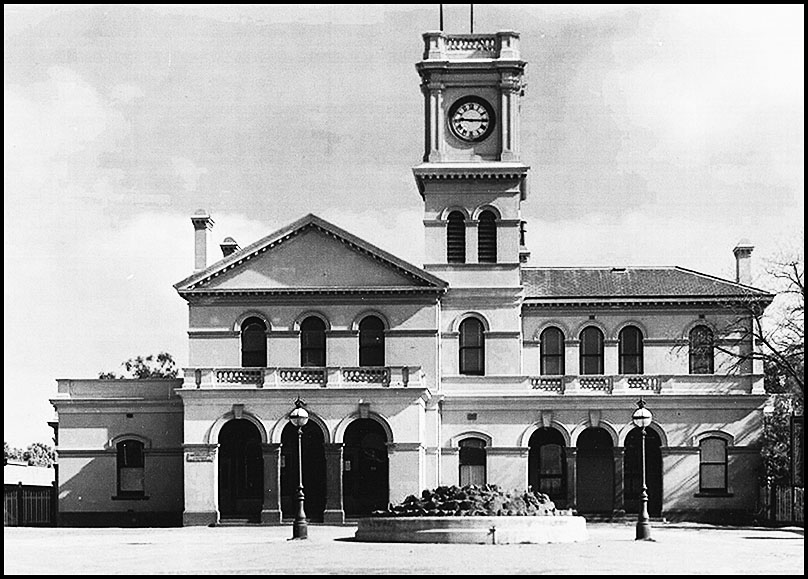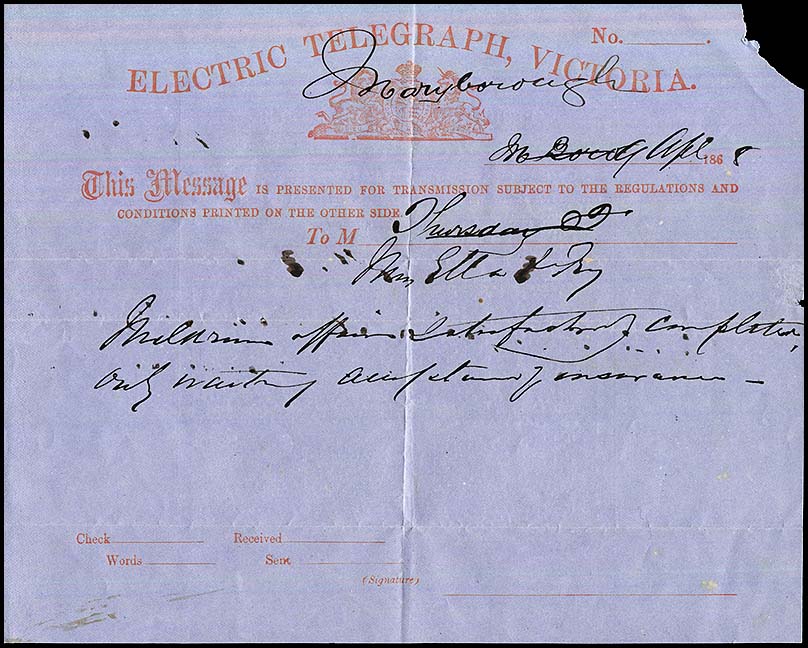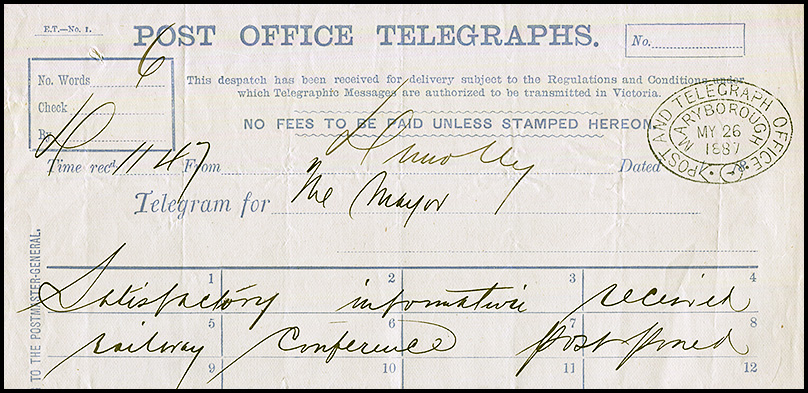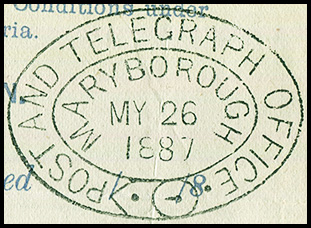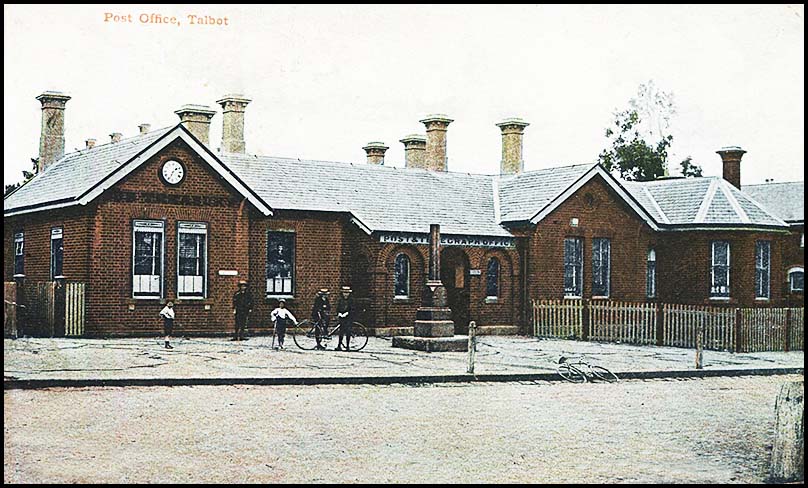Telegraph Offices before 1862 in the Central Victoria region.
- Australia 1901-1988
- New South Wales
- Queensland
- South Australia
- Tasmania
- Victoria
- Western Australia
- International
- Special aspects
The pre-1862 Telegraph Offices included from Central Victoria are listed in the following tables. Other Telegraph Offices developed post-1861 on specific lines are listed on pages for those separate lines.
| Avoca | Bacchus Marsh | Ballarat | Bendigo | Carisbrook | Castlemaine |
| Clunes | Creswick | Daylesford | Dunolly | Gisborne | Guilford |
| Kyneton | Maldon | Maryborough | Sandhurst | Talbot | Tarnagulla |
| Avoca.
The Telegraph Office was opened in March 1859. In the following year, there was considerable public and political discussion about the desirability of merging the Telegraph Office with the Post Office. A new Post and Telegraph Office was opened in February 1874. The Avoca Mail of 17 February observed: "The new Post and Telegraph Office were opened for the transaction of business yesterday morning, the necessary removal of instruments, etc., having been effected under the direction of Mr. Arkins without the slightest inconvenience to the public or loss of time. In fact the only time lost on the occasion has been by the clock which has been erected to keep it. The dial certainly lights up the front of the building and gives a finished appearance to the whole structure, but the townspeople would certainly prefer that it should be permitted to fulfill its intended usefulness as a time keeper. We understand that permission has now been received by Mr. Arkins to admit into the sacred precincts of the office the gentleman who has regulation of the clock's movements, so that this last difficulty has been satisfactorily overcome". |
|
The Office was issued with a 2 hole Belt & Buckle date stamp.
|
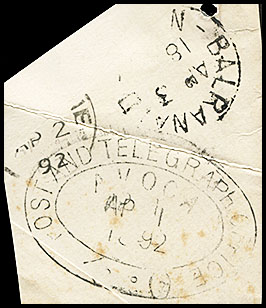 1 April 1892 (earliest recorded date). |
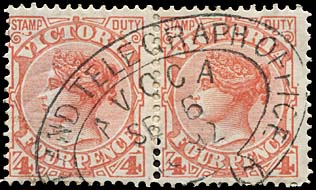 6 September 1892 (latest recorded date). |
|
|
In the Legislative Assembly of 28 February 1860, Mr. Prendergast inquired whether it was intended to make Carisbrook a Telegraph Station. In reply, Mr Bailey answered "it was not inasmuch as Carisbrook was not included in the Report by Mr. McGowan and he did not believe that a station at that township could be made remunerative". Personnel: 1 February 1861: Edmund Banks was appointed Manager of the new Electric Telegraph Office at Carisbrook - transferred from Sandridge. 18 November 1861, George E. Groves was appointed Postmaster to replace Edmund Banks who was transferred to Chiltern. 20 March 1866: James A. B. Smith was appointed acting operator in charge of the Electric Telegraph and Collector of Imposts also Postmaster at Carisbrook from 1st March 1866 vice Mr. G. W. Whitty, transferred. |
| Castlemaine (Mount Alexander).
The Telegraph Office opened telegraphic communication with Melbourne on 8 January 1857 and opened to the public on the afternoon of 9th. There was "a perfect storm of messages when the telegraph was first opened to the public and these continued without intermission till an unfortunate accident interrupted the communication. Luckily it was only a temporary suspension and, owing to the activity of Mr. Ballard, the Station Master, was soon remedied. We may here remark that the Government seems to have been peculiarly fortunate in the selection of a gentleman to fill the above post as the urbanity and wish to afford information to the public of Mr. Ballard have already won him golden opinions" (Mount Alexander Mail 16 January 1857). Some little excitement has been caused by the Municipal election. The Gazette of 5 December 1856 listed acceptance of the tender from Campbell and Thompson for the erection of a Telegraph office at Castlemaine for the sum of £1,162. In a survey of the Reserve in Lyttleton Street in July 1856, the District Surveyor (Mr. T. Adair) marked out various sites: "The Post Office is to occupy the corner of Barker Street and Lyttleton Street, the Telegraph Office at the opposite corner in Barker Street and the Mechanics' Institute being placed between the two". |
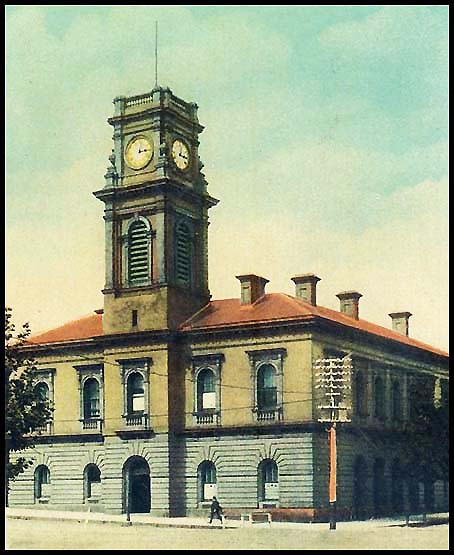 Castlemaine P&T Office pre-1910. |
|
By 8 December 1856, it was reported that a temporary office had been erected in Barker Street between the Sub-Treasury and the Post Office as a station for the Telegraph and on that day, the wires to Castlemaine were tested. The permanent opening took place on the following afternoon (Friday) in the temporary apartment erected on the reserve in Lyttleton Street and near the site of the telegraph office now in course of erection. Several gentlemen were present on the occasion including Thomas Andrews, Esq. Chairman of the Municipal Council who, we suppose, represented the community generally. Messages conveying compliments were exchanged with Sandhurst and Melbourne. Mr. McGowan worked the battery and courteously explained the mode of operation. The telegraph was then opened to public use. |
||
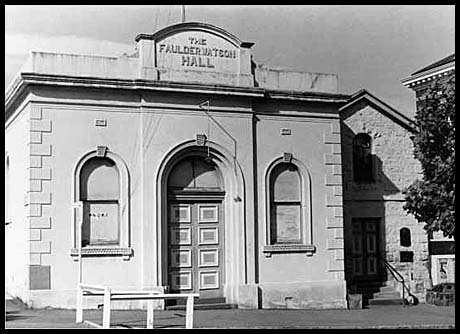 The original Telegraph Office used from 1857. Source: NLA jcoo4307. |
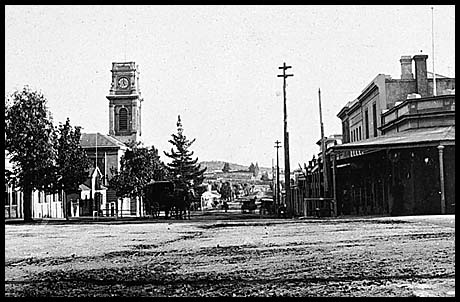 Castlemaine pre-1894 showing the P&T Office clock tower. |
|
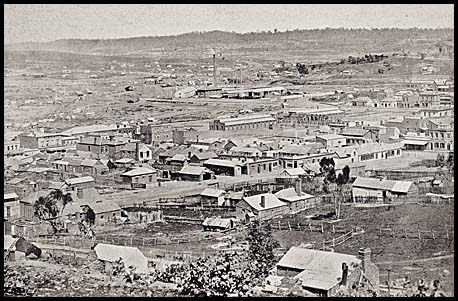 Castlemaine about 1870. |
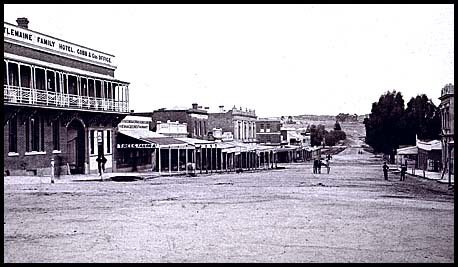 Castlemaine about 1899. |
|
The Gazette of 20 December 1859 announced Mr Thomas Green, to be Electric Telegraph Station Master at Castlemaine from 18th November, 1859 vice Mr T. R. Ballard. The Castlemaine Railway Station served as a Telegraph Office from 1910 before being reclassified a a Post Office in 1915. It reverted to a Telegraph Office about 1940 and was closed about 1950. The Mount Alexander Mail reported, on 19 November 1860, a major development in the telegraphic history of Castlemaine: "On the evening of the l8th of October, Mr Stapleton, Victorian station master at Mount Gambier, played a game of chess with Mr Green, Manager of the Castlemaine Station. The contest lasted from 9 to 10:30 pm. when Mount Gambier was 'check-mated'. Mr Stapleton tells me the moves were made with as much facility and the changes communicated as expeditiously as if his opponent had been sitting at the same board with him". So good to report this example of creativity with the new toy!!! Speed of transmission is always an important factor in telegraphic work. On 17 March 1883, The Age reported:
Personnel: July 1886: Mr. J. Coverdale, who had occupied the position of Post and Telegraph Master at Sale for the past 17 years, received instructions to proceed to the Castlemaine office. |
||
A 1 hole Belt and Buckle date stamp was issued to the office.
|
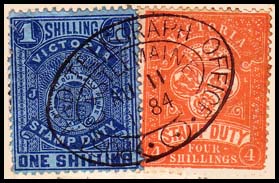 11 August 1884. Very rare use on 1/- and 4/- Stamp Duties. Provenance: Hugh Freeman, Johnstone. |
|
The usual postal date stamps were used on telegram forms. Both of the date stamps shown to the right were struck on telegram delivery forms. |
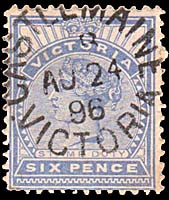 Unframed Castlemaine date stamp 24 August 1896. |
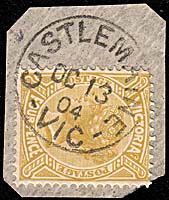 Framed Castlemaine date stamp 13 October 1904. |
The Office was issued with a 1 hole Belt & Buckle date stamp. The earliest recorded date of any Belt & Buckle date stamp was for 1 April 1880 at Clunes.
|
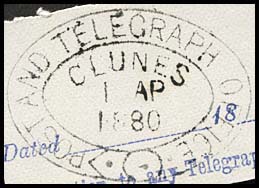 1 April 1880 (ERD). |
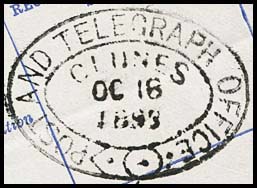 18 October 1893 (LRD). |
A triple oval date stamp (RO6-P&TO) is known to have been used at Clunes. It is the first date stamp to use the inscription Post & Telegraph Office apart from the Belt & Buckle design:
|
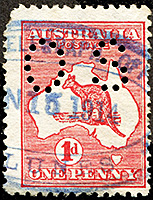 15 January 1914. |
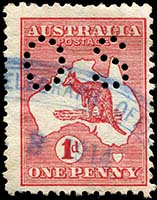 1914 (no month). |
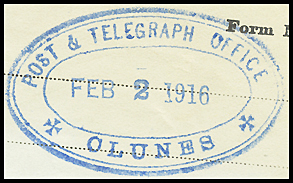 2 February 1916. Prestige Philately December 2010 Lot 469 |
||
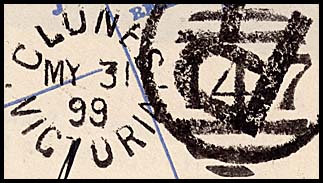 Clunes Barred Numeral duplex. 31 May 1899. Used on VC-DO- |
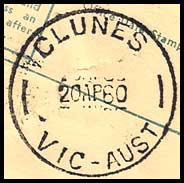 Usual postal date stamp with 6 mm side arcs and long date line . 20 April 1960. Diameter: 30.5 mm. |
| Creswick.
The Telegraph Office was opened in April 1859. The Gazette announced that Joshua Walter Nunn was to be Manager of the Creswick Post and Telegraph Office from 1 January 1861 in lieu of Mr. W. Burkitt who was being transferred to Beechworth. |
||
The Office was issued with a 1 hole Belt & Buckle date stamp.
|
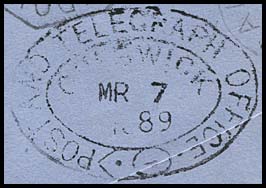 7 March 1889. On a long blue registered OHMS cover to Melbourne. Provenance: Max Watson, Johnstone. Mossgreen April 2017 Lot 381. |
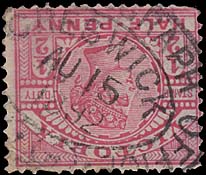 15 August 1892. Provenance: Freeman, Johnstone. |
Early use. The earliest evidence of the operation of the Daylesford Telegraph Office is a telegram delivery form (VC-DO-9) used for a message transmitted from Daylesford (probably to Abbot & Co. at Richmond on 8 November 1879. |
|
| The Daylesford Telegraph Office was issued two types of date stamp for use with telegrams: | |
|
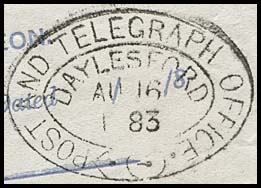 16 August 1883 (ERD). |
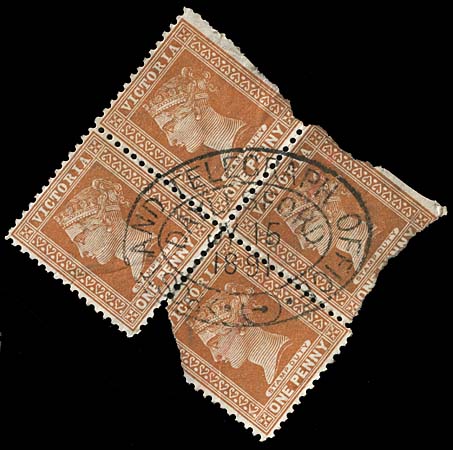 15 July 1891. |
|
|
|
|
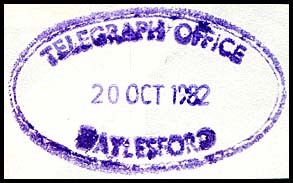 20 October 1982. |
The usual unframed postal canceller was also used with telegrams.. Like 80B in WWW but with a time code. |
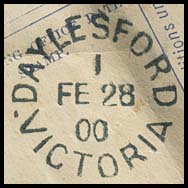 28 February 1900. Used on VC-DO-16B. |
| Dunolly.
The Telegraph Office opened in August 1859. The Herald of 24 August 1861 reported the following with the caveat that, as there is so much gold around Dunnoly, their news "would not attract more than ordinary notice. |
Photographer: G. H. Jenkinson. |
In March 1871, a tender was accepted from C. Walker for the erection of a new Post and Telegraph Office at Dunolly for £1,240 10s. A nugget of gold weighing 60 ozs was found at the end on 1874 by two miners (Robertson and Bragg) near Jones' Creek (close to Dunnolly). It was located 14 feetabout 4.25 m down and 60 yardsabout 55 m from the Burn's local store. The nugget was sold in January 1875 at the London Chartered Bank - the net yield of gold being 48 ozs 2 dwts. |
|
|
Gold was first discovered at Inglewood in 1859 with a major find in 1860. The 1860 find caused the town to move slightly south and it was called "New Inglewood". In that year, Post Offices were opened at both Inglewood and New Inglewood. The Telegraph Office opened on 25 October 1861. |
In 1862, a fire destroyed the commercial precinct in New Inglewood but it is not known if the Telegraph Office was destroyed. By 1865, about 40,000 people were in the town and the surrounding area. In April 1871, the Gazette noted approval of the payment of £117 to Joseph Jarvis to convert the old court-house at Inglewood into a Post and Telegraph Office. On 24 May 1880, the Bendigo Advertiser reported on the visit by a Ministerial party to Inglewood. "The Hon, Mr. Bent, Commissioner of Public Works, accompanied by the Mayor and Borough councillors, visited the Post and Telegraph office, which was found to consist of a large commodious and rather neat looking wooden building and to the casual observer would seem to be all that was required in that direction by a town like Inglewood. But a great objection is that, not only does it swallow up considerable sum yearly of public money in repairs, but from its inflammable nature stands in great danger of being at any moment swept away by fire. In the event of such a calamity occurring, documents, etc., might be destroyed which no money could replace. This was laid before Mr. Bent and a suggestion made that the Government should erect a new brick building, the Council joining and agreeing a town hall in conjunction therewith. The hon. gentleman promised to carefully consider the matter, but did not seem impressed with the necessity for a new post office while the present building stood". |
|
Early forms: The earliest indication of the operation of the Inglewood Telegraph Office is a message from Inglewood to Sandhurst on 1 October 1884 on a telegram delivery form (VC-DO-11B) - hence about 23 years after the Inglewood Telegraph Office became operational. |
|
| No special date stamps were ever issued to the Inglewood Telegraph Office. | |
Instead the usual postal date stamp (SC1) was used for telegraphic work.
|
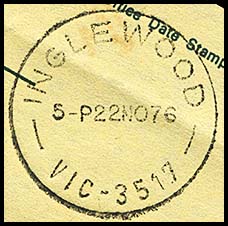 22 November 1976. Used on AA-DO-12Ca (71). |
A 2 hole Belt & Buckle date stamp was used at the Post & Telegraph Office.
|
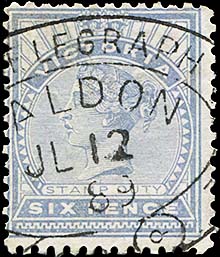 12 July 1889. |
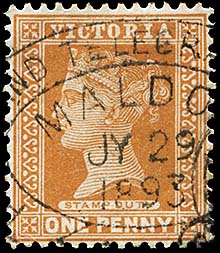 29 July 1893 |
|
||
| Datestamps for use on telegrams and for telegraphic-related purposes were issued to the Office in three formats: | |
1. A Belt & Buckle date stamp was issued to the Maryborough Post & Telegraph Office:
|
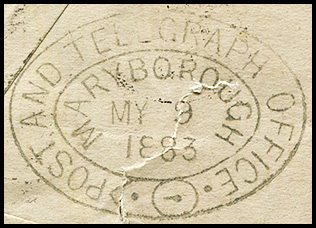 9 May 1883 (earliest recorded date). Used as an arrival backstamp on a Commercial Assurance Insurance Company cover sent from Melbourne to Maryborough and posted the previous day. |
| Other examples in black: | |||
|
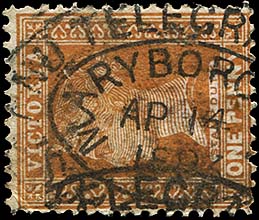 14 April 1893. |
||
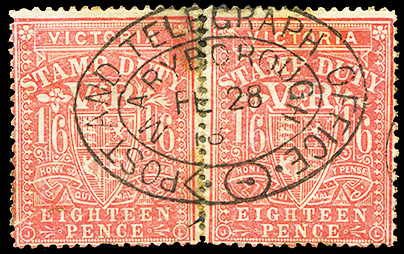 28 February 18?? - on a 1/6 Stamp Statute. Provenance: Hugh Freeman, Johnstone Collection. |
|||
2. Used in blue: 20 September 1888. |
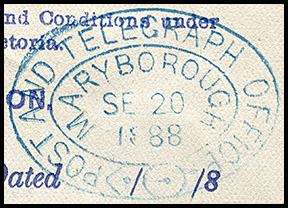 20 September 1888. Used on VC-DO-11C. |
| 3. A circular rubber TELEGRAPH datestamp (RC1-T) was also issued to the Maryborough Telegraph Office. It included both a postcode and a telephone number. | |
|
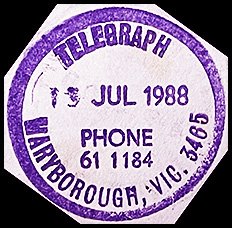 15 July 1988. Image courtesy of Dave Elsemore Scanned from an Australia Post Record of Postmark Impressions booklet completed in 1988-89. |
Used in black: 21 October 1988. |
 21 October 1988. |
Ordinary Postal date stamps used on telegrams.
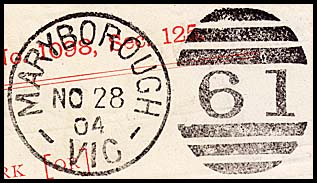 Maryborough "61" duplex. 28 November 1904. Used on VC-DO-19. |
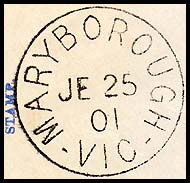 Maryborough 25 June 1901. Diameter: 25 mm. Used February 1897 - June 1901. Framed date stamp used on |
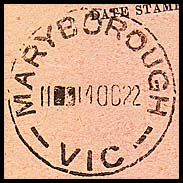 Maryborough 14 October 1922. Date stamp has time and date. |
 Maryborough boxed straight-line handstamp for use especially on telegrams. Used on AE-DO-1E on 29 July 1921. |
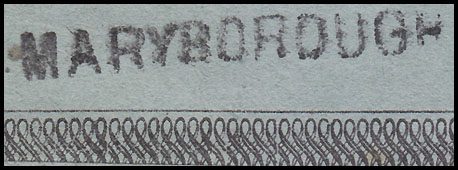 Maryborough unboxed straight-line handstamp for use especially on telegrams. Used on AE-DO-1E on 21 April 1921. |
|
|
A Telegraph Office was also opened at the Railway Station in Maryborough for use by the public as well as for railway duties. |
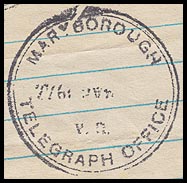 |
Maryborough V.R. strike for the date stamp below with reversed date wheels set to March 1944. |
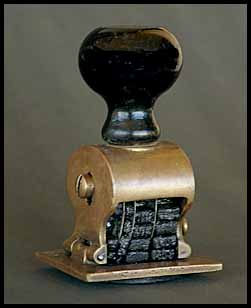 The date stamp for Maryborough. |
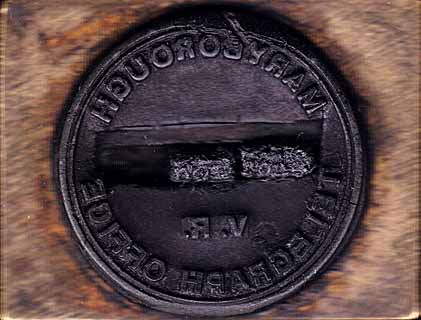 Steel date stamp for Maryborough Telegraph Office at the Railway Station. Note the V.R. (for Victorian Rail) below the centre. See also a Delayed date stamp. |
|
| Talbot (Back Creek).
The settlement was known as Back Creek until about 1855 and it was not officially named Talbot until October 1861. The Post Office had opened as Back Creek on 24 February 1854 and changed name on 14 February 1862. Telegraph wires were being stretched through Back Creek in mid-February 1860 although the Telegraph Office was not opened until 21 December 1860. In September 1850, a contract was let to Griffiths & Co for £1,330 to construct the Post and Telegraph Office. It finally replaced Amherst as the main town of the Municipality. |
||
|
||
The Office was issued with a 1 hole Belt & Buckle date stamp.
|
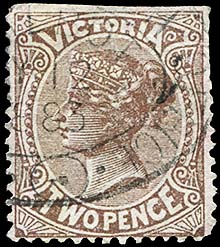 12 May 1883. |
|
| Tarnagulla.
The Telegraph Office opened on 18 November 1860 although the line from Dunolly had been completed on 1 November. The delay was occasioned by "the decease of the late manager at Tarnagulla occasioning a temporary interruption to the business of the office" (McGowan Report for 1860). The story is very sad and can be read in the Mount Alexander Mail of 16 November 1860. Tarnagulla had originally been called Sandy Creek. |
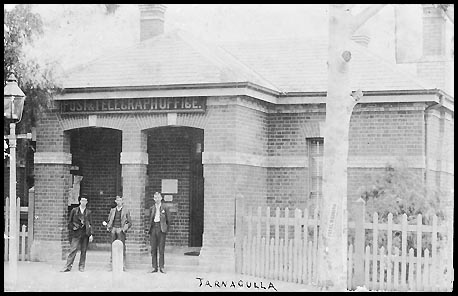 Tarnagulla Post and Telegraph Office about 1900. Tarnagulla Post and Telegraph Office about 1900. |
On 1 February 1861, the Gazette announced that Mr. Charles Mash Maplestone was to be the Manager of the Post and Telegraph Office at Tarnagulla from 1 January 1861 in lieu of Mr. R. Banks. |
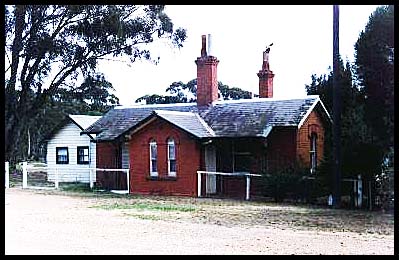 Tarnagulla Post and Telegraph Office - modern photograph. Tarnagulla Post and Telegraph Office - modern photograph. |
The Office was issued with a 1-hole Belt & Buckle date stamp.
|
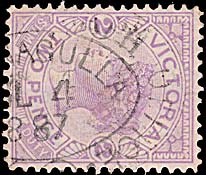 4 July 1887 - earliest recorded date. |
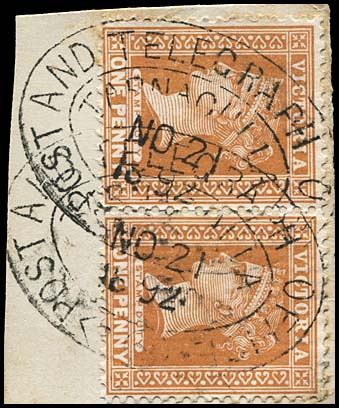 21 November 1892. |
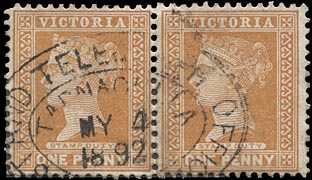 4 May 1892 on a pair of 1d brown Naish design. |
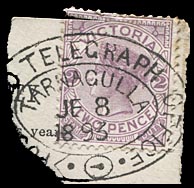 8 June 1893 |
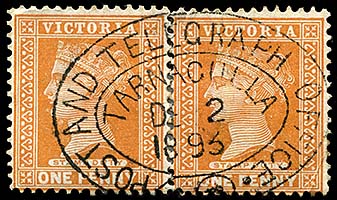 2 December 1893 - latest recorded date. |
|
